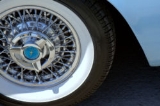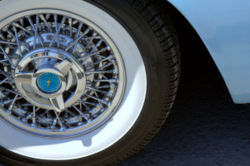
Whitewall tire
Encyclopedia

Rubber
Natural rubber, also called India rubber or caoutchouc, is an elastomer that was originally derived from latex, a milky colloid produced by some plants. The plants would be ‘tapped’, that is, an incision made into the bark of the tree and the sticky, milk colored latex sap collected and refined...
.
Background
Early automobile tires were made entirely of natural white rubber. However, the white rubber did not offer sufficient traction and endurance, so carbon blackCarbon black
Carbon black is a material produced by the incomplete combustion of heavy petroleum products such as FCC tar, coal tar, ethylene cracking tar, and a small amount from vegetable oil. Carbon black is a form of amorphous carbon that has a high surface-area-to-volume ratio, although its...
was added to the rubber used for the treads. Using carbon black
Carbon black
Carbon black is a material produced by the incomplete combustion of heavy petroleum products such as FCC tar, coal tar, ethylene cracking tar, and a small amount from vegetable oil. Carbon black is a form of amorphous carbon that has a high surface-area-to-volume ratio, although its...
only in the tread produced tires with inner and outer sidewalls of white rubber. Later, entirely black tires became available, the still extant white sidewalls being covered with a somewhat thin, black colored layer of rubber. Should a black sidewall tire have been severely scuffed against a curb, the underlying white rubber would be revealed; it is in a similar manner that raised white letter (RWL) tires are made.
Overview
The status of whitewall tires versus blackwall tires was originally the reverse of what it later became, with fully black tires requiring a greater amount of carbon blackCarbon black
Carbon black is a material produced by the incomplete combustion of heavy petroleum products such as FCC tar, coal tar, ethylene cracking tar, and a small amount from vegetable oil. Carbon black is a form of amorphous carbon that has a high surface-area-to-volume ratio, although its...
and less effort to maintain a clean appearance these were considered the premium tire; since the black tires first became available they were commonly fitted to many luxury cars through the 1930s. During the late-1920s gleaming whitewalls contrasted against darker surroundings were considered a stylish, but high-maintenance feature. The popularity of whitewalls as an option increased during the 1930s, while automobile streamlining and skirted fenders eventually rendered the two-sided whitewall obsolete.

World War II
World War II, or the Second World War , was a global conflict lasting from 1939 to 1945, involving most of the world's nations—including all of the great powers—eventually forming two opposing military alliances: the Allies and the Axis...
and the Korean War
Korean War
The Korean War was a conventional war between South Korea, supported by the United Nations, and North Korea, supported by the People's Republic of China , with military material aid from the Soviet Union...
.
Wide whitewall tires reached their zenith in popularity by the early-1950s. The 1957 production version of the Cadillac Eldorado Brougham was fitted with whitewalls that were reduced to a 1" wide stripe floating on the tire sidewall with a black area between this stripe and the wheel rim. The whitewall stripe width began to diminish as an attempt to reduce the perceived height of the wheel/tire, during the decade increasingly lower vehicle heights were in vogue.
Wide whitewalls generally fell out of favor in the U.S. by the 1962 model year. They continued as an option on the Lincoln Continental
Lincoln Continental
The Lincoln Continental is an automobile which was produced by the Lincoln division of Ford Motor Company from 1939 to 1948 and again from 1956 to 2002...
for some time thereafter but most common were narrower 3/4"-1" stripe whitewalls. During the mid-1960s variations on the striped whitewall began to appear; a red/white stripe combination was offered on Thunderbirds and other high-end Fords, and triple white stripe variations were offered on Cadillacs, Lincolns, and Imperials. Whitewall tires were a popular option on new cars during the 1950s and 1960s, as well as in the replacement market.
Maintaining a clean sidewall was an issue. Some motorists added aftermarket "curb feeler
Curb feeler
Curb feelers or curb finders are springs or wires installed on a vehicle which act as "whiskers" to warn drivers that they are too close to the curb or other obstruction.The devices are fitted low on the body, close to the wheels...
s" that were attached at the bottom of the wheel opening lip to help reduce scraping the whitewall tire against curbs
Curb (road)
A curb, or kerb , is the edge where a raised pavement/sidewalk/footpath, road median, or road shoulder meets an unraised street or other roadway.-Function:...
.
By 1968, wide whitewall tires were no longer available on the Chevrolet Corvette
Chevrolet Corvette
The Chevrolet Corvette is a sports car by the Chevrolet division of General Motors that has been produced in six generations. The first model, a convertible, was designed by Harley Earl and introduced at the GM Motorama in 1953 as a concept show car. Myron Scott is credited for naming the car after...
; replaced by F70xl5 bias-ply nylon cord tires with thin stripes, either a narrow white or narrow red stripe.
The single-sided whitewall remained a desirable option through the 1970s, becoming a hallmark of "traditional luxury". In some cases, having whitewall tires were a "must have" to get the right look on a car; and for those who could not afford the real deal, add-ons could be installed over the rim of the wheel that could leak if the pressure was too high.
Modern
Full-fledged wide whitewalls had made a return within the pimpmobilePimpmobile
Largely an American phenomenon, pimpmobile is a term used to describe a large luxury vehicle, usually a 1960s or early 1970s-model Lincoln or Cadillac vehicle, that has been customized in a garish, extravagant and kitsch or camp style...
culture. The resurgence of traditional hot rods, customs, lowriders and resto-cal cars have also contributed to the resurgence in whitewall tires.
Although wide whitewalls are virtually nonexistent as a factory option on modern automobiles, they are still manufactured in original bias-ply or radial form by specialty outlets. The last car available in the United Kingdom with whitewall tyres was the Kia Pride. Some companies manufacture wide whitewall inserts - the so-called "Portawall" inserts are usually sold through Volkswagen Beetle
Volkswagen Beetle
The Volkswagen Type 1, widely known as the Volkswagen Beetle or Volkswagen Bug, is an economy car produced by the German auto maker Volkswagen from 1938 until 2003...
restoration companies.
Modern trends toward more minimal styling, and large wheels favoring very low-profile tires leave little room for a whitewall. As of 2010 the Lincoln Town Car
Lincoln Town Car
The Lincoln Town Car is a full-size luxury sedan that was sold by the upscale Lincoln division of Ford Motor Company; it was produced from 1981 to the 2011 model years...
was the only new vehicle offered with a factory whitewall option, a narrow white stripe.

